LEO-Assisted Aerial Deployment in Post-Disaster Scenarios Using a Combinatorial Bandit and Genetic Algorithmic Approach
Abstract
:1. Introduction
- We propose to split the LEO-Sat assisted aerials deployment problem into two sub-problems. This is enabled by aerials’ TX powers towards the LEO-Sat, and the LEO-Sat bandwidth resources should be allocated based on aerials’ traffic needs after deployment. In this regard, the first sub-problem deals with the limited battery budget fair aerials deployment, and the second one deals with optimizing the aerials’ TX powers and LEO-Sat bandwidth resources according to the aerials’ traffic needs.
- A budget-constrained combinatorial multi-armed bandit (MAB) game with arms’ fairness (CB-BFC) [19] will be proposed to address the first sub-problem. In this context, MAB is an advanced online learning tool where a player intends to increase his achievable profit via playing over the bandit’s arms. Only through the exploitation–exploration process, without knowing any prior knowledge about the game, the player learns how to always play with the highest-profited arm. In the sub-problem considered, the MAB player will be the nearest survival GBS, the arms will be the post-disaster clusters, and the rewards are the aerials’ achievable data rates.
- To ensure fairness in clusters coverage based on users’ densities, we propose that GPS localization will be used to pre-estimate users’ locations, which will be refined through the aerials’ exploration during the proposed combinatorial MAB game.
- In the second sub-problem and after distributing the aerials among clusters, a genetic algorithm (GA) approach [20] will be utilized to optimize the aerials’ TX powers and LEO-Sat’s bandwidth resources based on the aerials’ traffic coming from users’ loads in their covered clusters. GA is a well-known optimization algorithm that can effectively address constrained non-linear optimization problems by means of penalty hypothesis.
- Extensive numerical analysis is conducted to confirm the effectiveness of the envisioned approach against benchmark schemes, including basic MAB approaches.
2. Related Work
3. System Model
3.1. Aerial-UD Linkage Model
3.2. LEO–Aerial Linkage Model
3.3. Optimization Problem Formulation
4. Proposed CB-FBC and Genetic Approach
4.1. Optimization of
| Algorithm 1: Proposed CB-FBC Algorithm implemented in GBS |
 |
4.2. Optimization of and
| Algorithm 2: Proposed GA implemented in GBS |
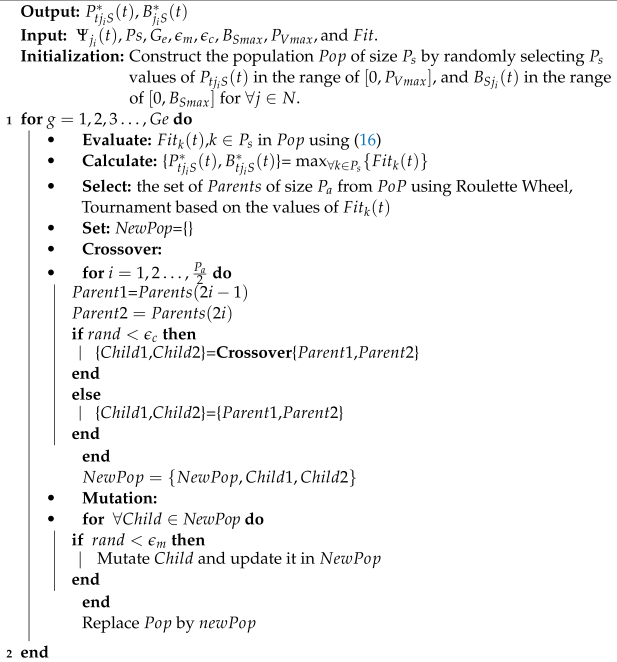 |
5. Numerical Analysis
5.1. Performance Analysis
5.2. Computational Complexity Analysis
6. Conclusions
Author Contributions
Funding
Data Availability Statement
Conflicts of Interest
References
- Hashesh, A.O.; Hashima, S.; Zaki, R.M.; Fouda, M.M.; Hatano, K.; Eldien, A.S.T. AI-Enabled UAV Communications: Challenges and Future Directions. IEEE Access 2022, 10, 92048–92066. [Google Scholar] [CrossRef]
- Mozaffari, M.; Saad, W.; Bennis, M.; Nam, Y.H.; Debbah, M. A Tutorial on UAVs for Wireless Networks: Applications, Challenges, and Open Problems. IEEE Commun. Surv. Tutor. 2019, 21, 2334–2360. [Google Scholar] [CrossRef]
- Nomikos, N.; Gkonis, P.K.; Bithas, P.S.; Trakadas, P. A Survey on UAV-Aided Maritime Communications: Deployment Considerations, Applications, and Future Challenges. IEEE Open J. Commun. Soc. 2023, 4, 56–78. [Google Scholar] [CrossRef]
- Zhang, S.; Liu, J. Analysis and Optimization of Multiple Unmanned Aerial Vehicle-Assisted Communications in Post-Disaster Areas. IEEE Trans. Veh. Technol. 2018, 67, 12049–12060. [Google Scholar] [CrossRef]
- Hashima, S.; Hatano, K.; Mohamed, E.M. Multiagent Multi-Armed Bandit Schemes for Gateway Selection in UAV Networks. In Proceedings of the 2020 IEEE Globecom Workshops (GC Workshops), Taipei, Taiwan, 7–11 December 2020; pp. 1–6. [Google Scholar]
- Mohamed, E.M.; Hashima, S.; Hatano, K. Energy Aware Multiarmed Bandit for Millimeter Wave-Based UAV Mounted RIS Networks. IEEE Wirel. Commun. Lett. 2022, 11, 1293–1297. [Google Scholar] [CrossRef]
- Guo, F.; Lu, L.; Zang, Z.; Shikh-Bahaei, M. Machine Learning for Predictive Deployment of UAVs With Multiple Access. IEEE Open J. Commun. Soc. 2023, 4, 908–921. [Google Scholar] [CrossRef]
- Leyva-Mayorga, I.; Soret, B.; Röper, M.; Wübben, D.; Matthiesen, B.; Dekorsy, A.; Popovski, P. LEO Small-Satellite Constellations for 5G and Beyond-5G Communications. IEEE Access 2020, 8, 184955–184964. [Google Scholar] [CrossRef]
- Elhalawany, B.M.; Gamal, C.; Elsayed, A.; Elsherbini, M.M.; Fouda, M.M.; Ali, N. Outage Analysis of Coordinated NOMA Transmission for LEO Satellite Constellations. IEEE Open J. Commun. Soc. 2022, 3, 2195–2202. [Google Scholar] [CrossRef]
- Deng, R.; Di, B.; Zhang, H.; Kuang, L.; Song, L. Ultra-Dense LEO Satellite Constellations: How Many LEO Satellites Do We Need? IEEE Trans. Wirel. Commun. 2021, 20, 4843–4857. [Google Scholar] [CrossRef]
- Dong, C.; Xu, X.; Liu, A.; Liang, X. Load balancing routing algorithm based on extended link states in LEO constellation network. China Commun. 2022, 19, 247–260. [Google Scholar] [CrossRef]
- Mokhtar, A.; Azizoglu, M. On the downlink throughput of a broadband LEO satellite network with hopping beams. IEEE Commun. Lett. 2000, 4, 390–393. [Google Scholar] [CrossRef]
- Li, J.; Xue, K.; Liu, J.; Zhang, Y. A User-Centric Handover Scheme for Ultra-Dense LEO Satellite Networks. IEEE Wirel. Commun. Lett. 2020, 9, 1904–1908. [Google Scholar] [CrossRef]
- You, L.; Li, K.X.; Wang, J.; Gao, X.; Xia, X.G.; Ottersten, B. Massive MIMO Transmission for LEO Satellite Communications. IEEE J. Sel. Areas Commun. 2020, 38, 1851–1865. [Google Scholar] [CrossRef]
- Hao, Y.; Song, Z.; Zheng, Z.; Zhang, Q.; Miao, Z. Joint Communication, Computing, and Caching Resource Allocation in LEO Satellite MEC Networks. IEEE Access 2023, 11, 6708–6716. [Google Scholar] [CrossRef]
- Singya, P.K.; Alouini, M.S. Performance of UAV-Assisted Multiuser Terrestrial-Satellite Communication System over Mixed FSO/RF Channels. IEEE Trans. Aerosp. Electron. Syst. 2022, 58, 781–796. [Google Scholar] [CrossRef]
- Ma, T.; Zhou, H.; Qian, B.; Cheng, N.; Shen, X.; Chen, X.; Bai, B. UAV-LEO Integrated Backbone: A Ubiquitous Data Collection Approach for B5G Internet of Remote Things Networks. IEEE J. Sel. Areas Commun. 2021, 39, 3491–3505. [Google Scholar] [CrossRef]
- Tran, D.H.; Chatzinotas, S.; Ottersten, B. Satellite- and Cache-Assisted UAV: A Joint Cache Placement, Resource Allocation, and Trajectory Optimization for 6G Aerial Networks. IEEE Open J. Veh. Technol. 2022, 3, 40–54. [Google Scholar] [CrossRef]
- Auer, P.; Cesa-Bianchi, N.; Fischer, P. Finite-time Analysis of the Multiarmed Bandit Problem. Mach. Learn. 2002, 47, 235–256. [Google Scholar] [CrossRef]
- Holland, J.H. Genetic Algorithms. Sci. Am. 1992, 267, 66–73. [Google Scholar] [CrossRef]
- Huang, H.; Savkin, A.V. Deployment of Heterogeneous UAV Base Stations for Optimal Quality of Coverage. IEEE Internet Things J. 2022, 9, 16429–16437. [Google Scholar] [CrossRef]
- Ahmed, S.; Chowdhury, M.Z.; Jang, Y.M. Energy-Efficient UAV Relaying Communications to Serve Ground Nodes. IEEE Commun. Lett. 2020, 24, 849–852. [Google Scholar] [CrossRef]
- Mohamed, E.M. LEO satellite assisted UAV distribution using combinatorial bandit with fairness and budget constraints. PLoS ONE 2023, 18, e0290432. [Google Scholar] [CrossRef]
- Sabzehali, J.; Shah, V.K.; Fan, Q.; Choudhury, B.; Liu, L.; Reed, J.H. Optimizing Number, Placement, and Backhaul Connectivity of Multi-UAV Networks. IEEE Internet Things J. 2022, 9, 21548–21560. [Google Scholar] [CrossRef]
- Al-Hourani, A.; Kandeepan, S.; Lardner, S. Optimal LAP Altitude for Maximum Coverage. IEEE Wirel. Commun. Lett. 2014, 3, 569–572. [Google Scholar] [CrossRef]
- Jia, Z.; Sheng, M.; Li, J.; Niyato, D.; Han, Z. LEO-Satellite-Assisted UAV: Joint Trajectory and Data Collection for Internet of Remote Things in 6G Aerial Access Networks. IEEE Internet Things J. 2021, 8, 9814–9826. [Google Scholar] [CrossRef]
- Chen, W.; Wang, Y.; Yuan, Y. Combinatorial Multi-Armed Bandit: General Framework and Applications. In Proceedings of the 30th International Conference on Machine Learning, Atlanta, GA, USA, 17–19 June 2013; Dasgupta, S., McAllester, D., Eds.; Proceedings of Machine Learning: Pittsburgh, PA, USA; Volume 28, pp. 151–159. [Google Scholar]
- Sinha, D.; Sankararama, K.A.; Kazerouni, A.; Avadhanula, V. Multi-Armed Bandits with Cost Subsidy. In Proceedings of the AISTATS, Virtual, 18 September 2021. [Google Scholar]
- Li, F.; Liu, J.; Ji, B. Combinatorial Sleeping Bandits With Fairness Constraints. IEEE Trans. Netw. Sci. Eng. 2020, 7, 1799–1813. [Google Scholar] [CrossRef]
- Mohamed, E.M.; Hashima, S.; Hatano, K.; Kasban, H.; Rihan, M. Millimeter-Wave Concurrent Beamforming: A Multi-Player Multi-Armed Bandit Approach. Comput. Mater. Contin. 2020, 65, 1987–2007. [Google Scholar] [CrossRef]
- Mohamed, E.M.; Hashima, S.; Aldosary, A.; Hatano, K.; Abdelghany, M.A. Gateway Selection in Millimeter Wave UAV Wireless Networks Using Multi-Player Multi-Armed Bandit. Sensors 2020, 20, 3947. [Google Scholar] [CrossRef]
- Beyer, H.G.; Schwefel, H.P.; Wegener, I. How to analyze evolutionary algorithms. Theor. Comput. Sci. 2002, 287, 101–130. [Google Scholar] [CrossRef]
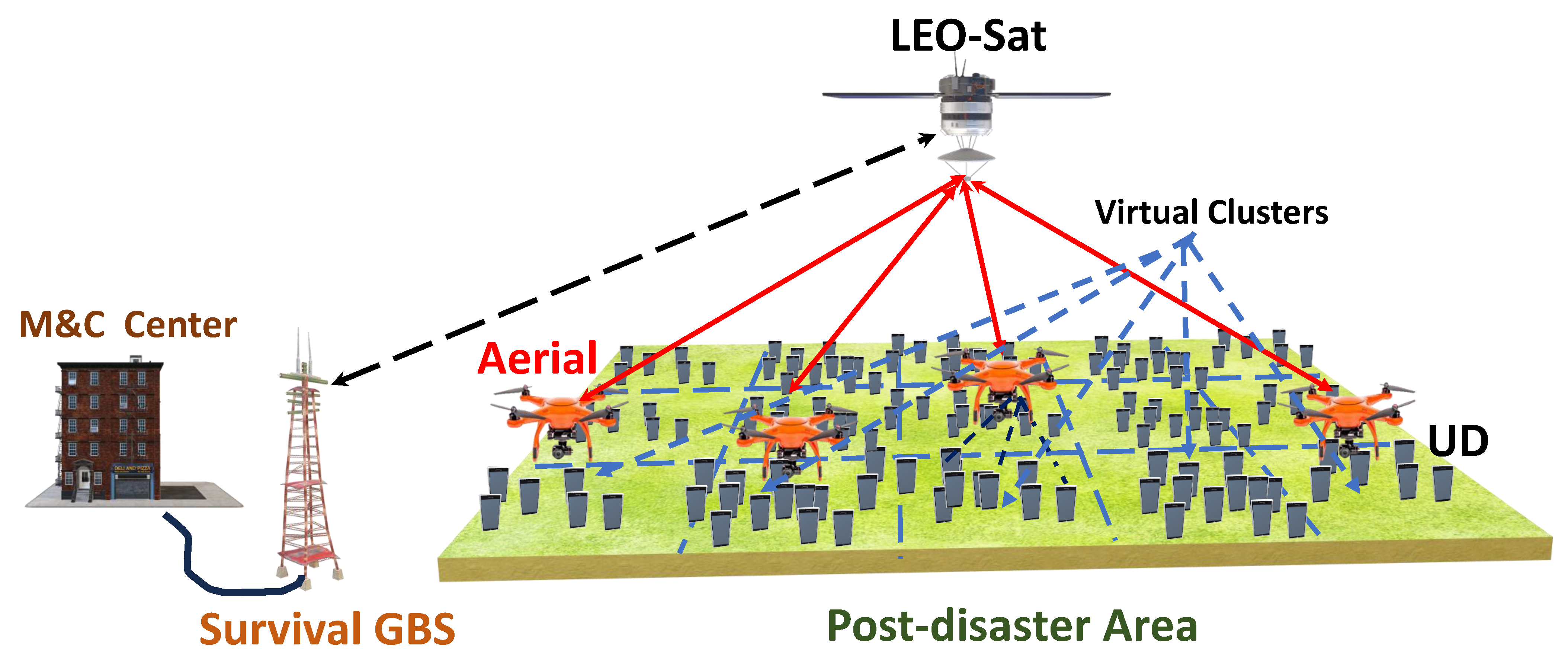
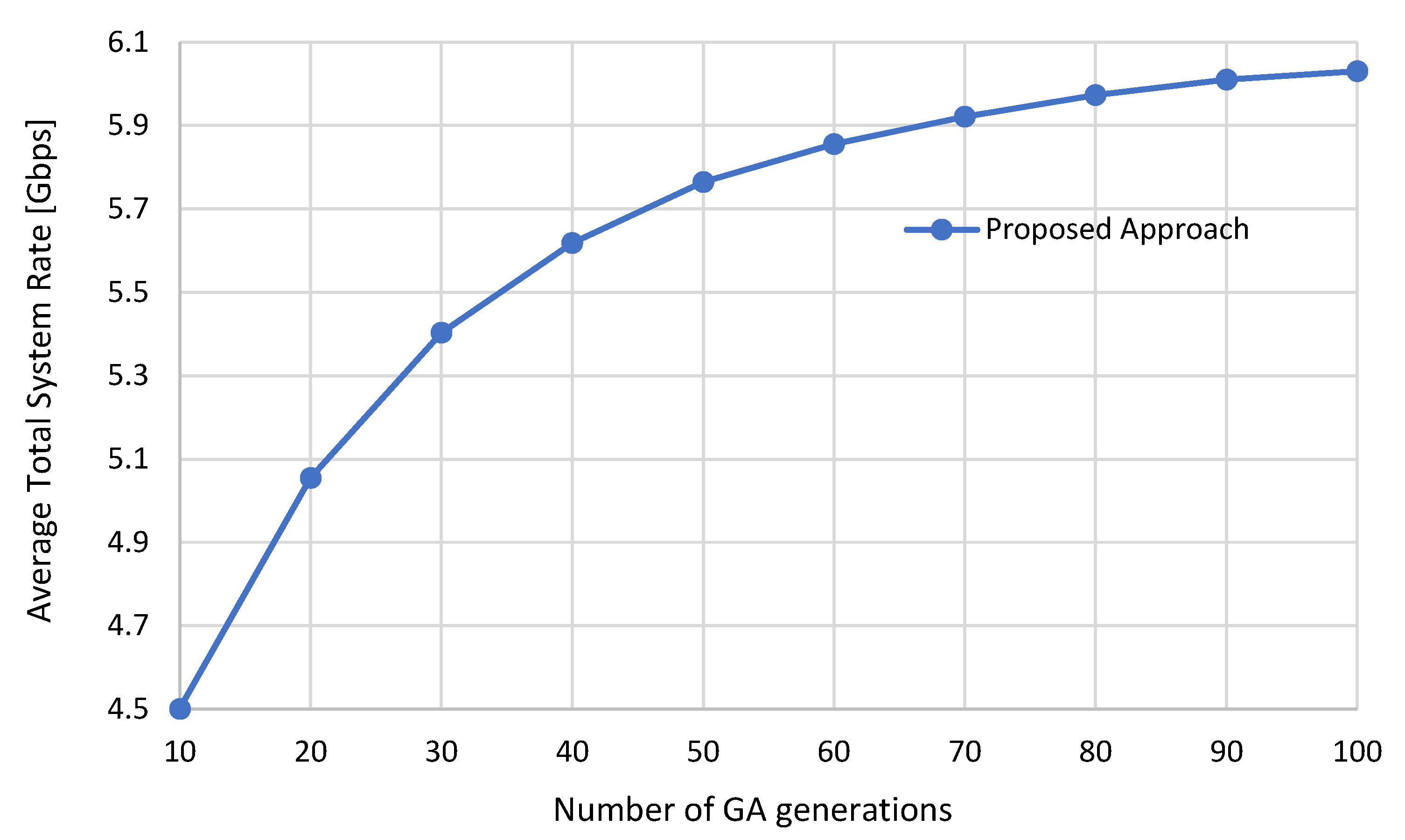


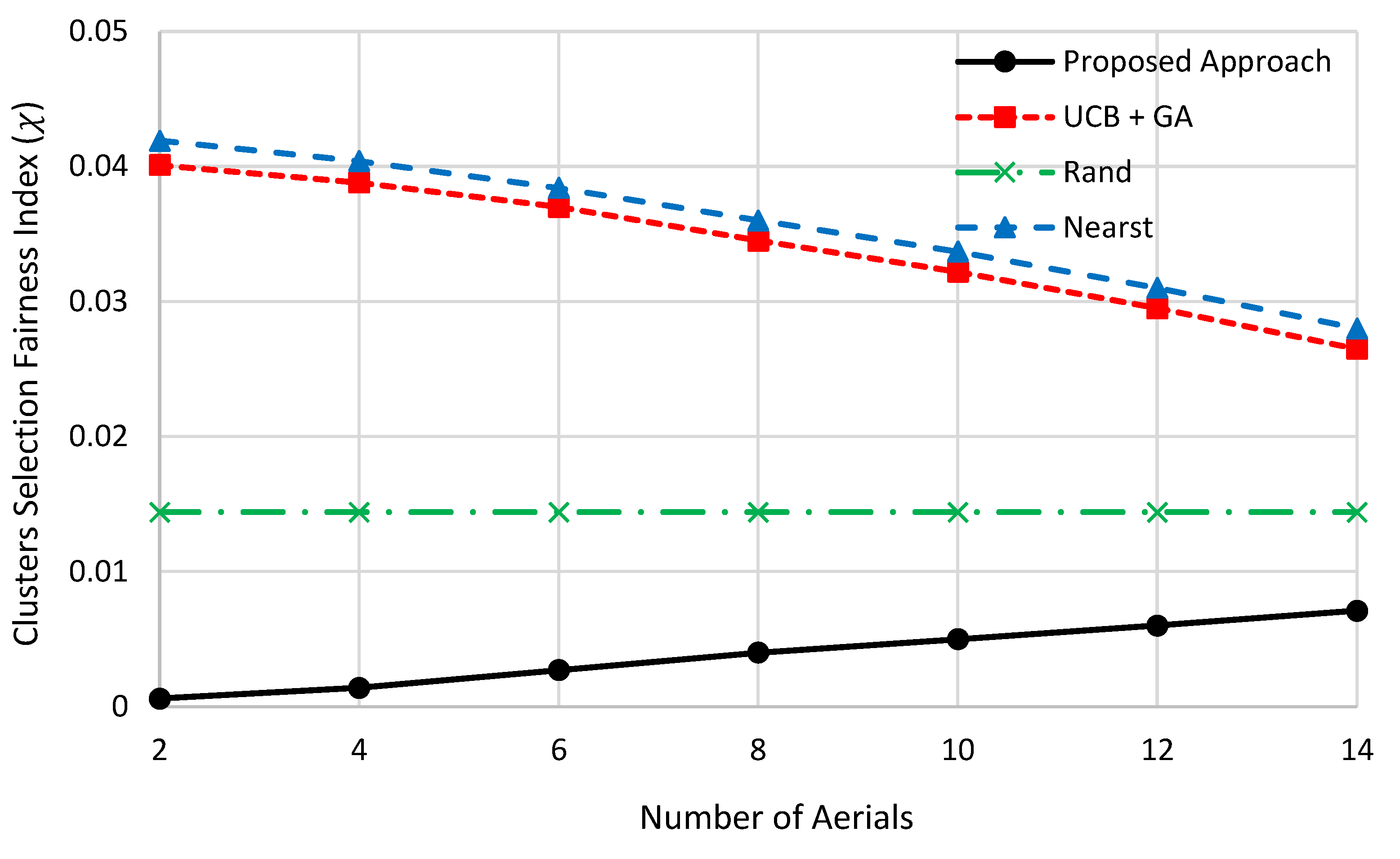
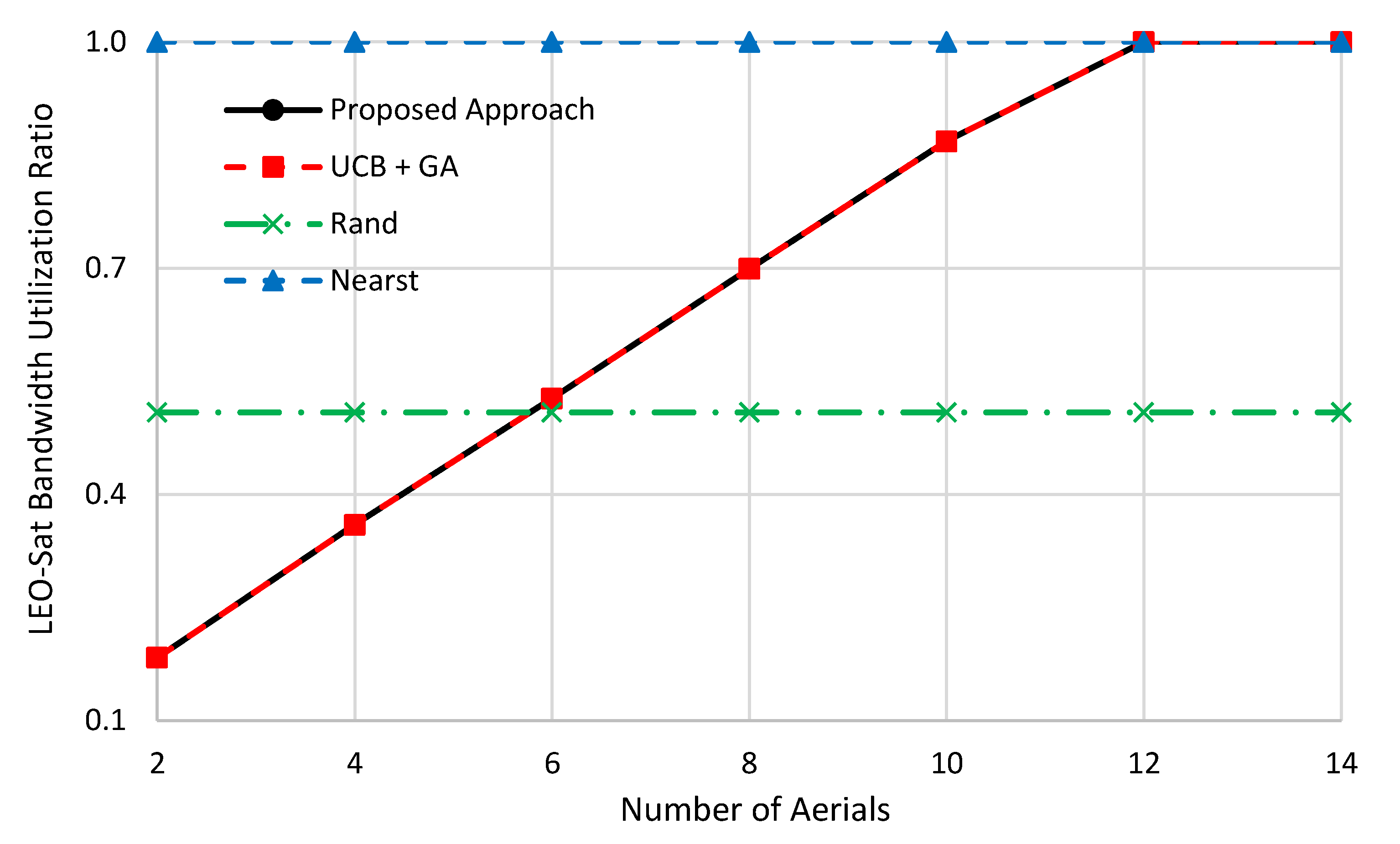
| Parameter | Value |
|---|---|
| , | 100 MHz [26], 40 MHz [24] |
| , | 1 Watt, 10 Watt [26] |
| Uniformly random in the range [1, 100] | |
| , | 2 GHz [24], 2.4 GHz [26] |
| −174 + 10log10(W) + 10 [30] | |
| , | 4, 2 Watt [31] |
| and | 1000 and 1.38 × [26] |
| and | 0.1 dB and 21 dB [24] |
| UD data load | 5 Gbit |
| T, | 1000, 0.01 |
| 15 dB [26] | |
| a, b | 4.88, 0.429 [24] |
Disclaimer/Publisher’s Note: The statements, opinions and data contained in all publications are solely those of the individual author(s) and contributor(s) and not of MDPI and/or the editor(s). MDPI and/or the editor(s) disclaim responsibility for any injury to people or property resulting from any ideas, methods, instructions or products referred to in the content. |
© 2023 by the authors. Licensee MDPI, Basel, Switzerland. This article is an open access article distributed under the terms and conditions of the Creative Commons Attribution (CC BY) license (https://creativecommons.org/licenses/by/4.0/).
Share and Cite
Mohamed, E.M.; Hashima, S.; Hatano, K.; Khallaf, H.S. LEO-Assisted Aerial Deployment in Post-Disaster Scenarios Using a Combinatorial Bandit and Genetic Algorithmic Approach. Electronics 2023, 12, 4964. https://doi.org/10.3390/electronics12244964
Mohamed EM, Hashima S, Hatano K, Khallaf HS. LEO-Assisted Aerial Deployment in Post-Disaster Scenarios Using a Combinatorial Bandit and Genetic Algorithmic Approach. Electronics. 2023; 12(24):4964. https://doi.org/10.3390/electronics12244964
Chicago/Turabian StyleMohamed, Ehab Mahmoud, Sherief Hashima, Kohei Hatano, and Haithem S. Khallaf. 2023. "LEO-Assisted Aerial Deployment in Post-Disaster Scenarios Using a Combinatorial Bandit and Genetic Algorithmic Approach" Electronics 12, no. 24: 4964. https://doi.org/10.3390/electronics12244964
APA StyleMohamed, E. M., Hashima, S., Hatano, K., & Khallaf, H. S. (2023). LEO-Assisted Aerial Deployment in Post-Disaster Scenarios Using a Combinatorial Bandit and Genetic Algorithmic Approach. Electronics, 12(24), 4964. https://doi.org/10.3390/electronics12244964









